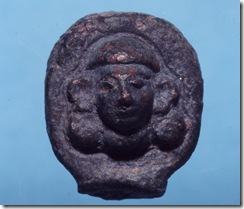In the period of the judges,
the Lord sold [the Israelites] into the hands of Jabin, a king of Canaan, who reigned in Hazor. The commander of his army was Sisera, who lived in Harosheth Haggoyim. Because he had nine hundred iron chariots and had cruelly oppressed the Israelites for twenty years, they cried to the Lord for help (Judges 4:2-3).
Archaeologist Adam Zertal believes he has identified Sisera’s hometown of Harosheth Haggoyim at the site of el-Ahwat not far from the Jezreel Valley. A bronze tablet discovered in the excavation was a linchpin of a chariot wheel. Enemies were sometimes carved on these linchpins as a sign of disrespect, not unlike depictions of a king putting his foot on the necks of his enemies. The woman depicted on the linchpin may be a Hittite goddess. Zertal connects this artifact to the story of Sisera’s defeat by Deborah and Barak:
This identification enhances the historical and archaeological value of the site and proves that chariots belonging to high-ranking individuals were found there. It provides support for the possibility, which has not yet been definitively established, that this was Sisera’s city of residence and that it was from there that the chariots set out on their way to the battle against the Israelite tribes, located between the ancient sites of Taanach and Megiddo.
Zertal further identifies Sisera as one of the Sea Peoples. The Philistines are the most well known, but another group were the Shardanu who originated from Sardinia.
More details are given in the press release of the University of Haifa (with good illustrations). The Jerusalem Post story has additional information apparently based on Zertal’s new book, Sisera’s Secret, A Journey following the Sea-Peoples and the Song of Deborah.
Anson Rainey argues at length that Harosheth Haggoyim is not a city but a region, and the name should be translated as “district of the foreigners.” He locates it in the plain east of Megiddo, and thus equivalent to “at Taanach on the waters of Megiddo” in Judges 5:19. For his analysis, see The Sacred Bridge, pp. 137-38, 150-51.
